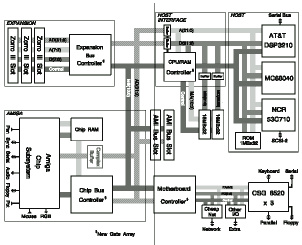
ACUTIATOR
Developer: Commodore
Year of development: 1990-91 |
Acutiator was a new Commodore Amiga architecture designed by
Dave Haynie between 1990 and 1991. It was the code name for a new
system-level architecture for low and high end devices. The
Acutiator architecture define the building blocks for a cost
effective, high performance 68040-based system. Following Dave
Haynie's move from custom to industry standard design, the
Acutiator would have been entirely modular, allowing the use of a
series of Amiga custom chips. The architectural outline envisions a
range of AGA, AA+, and AAA systems using 68040, 060 or even
RISC-based processors, all using the Acutiator model. In a similar
style to the BoXeR boards of today, the system was to be entirely
modular in design with a system board design that was independent
of CPU or graphics subsystems. The design was originally to use
Dave Haynies' design, the Amiga Modular Interconnect bus, but with
the release of the similar PCI bus it swapped to this.
Architectural Specifications, taken from Dave Haynie's PDF
document.

Motherboard Subsystem
All Acutiator-based models were based around a motherboard
subsystem. This would provide basic functions such as DRAM and
standard I/O management. A modular Acutiator motherboard would have
AMI bus slots, single DRAM bus slot, and a few 'special' I/O bus
slots for signals between the motherboard and AMI bus modules.
Motherboard Controller
The main Acutiator bus controller replaces and enhances some of the
functions found in Ramsey, Gary and Buster on the A3000.
AMI Bus
The Acutiator Modular Interconnect is a modular bus designed for a
range of Motorola 68k processors. It is based somewhat upon the
68040 bus protocols. It can also mesh with alternate processor such
as DSP or SCSI (to the right of the above diagram). The slots can
be fitted with several coprocessors, all assisting the host
processor.
SCSI Processor
For a high performance system, a DMA SCSI interface is required.
The Acutiator specifications of the time recommend a NCR 53C710
SCSI-2 controller to be interfaced with the AMI Bus or the
processor local bus. The implementation of a SCSI processor would
have been a dramatic improvement in comparison to Amiga SCSI,
promising 10Mb/S fast synchronous mode. The I/O bus would also
support IDE, most likely for a low-end design.
Signal Processor
The choice of AT&T DSP3210 provided a fast processor for
performing tasks that would have otherwise slowed the system down,
performing tasks 10x the speed of the 68040. The system would have
been capable of both audio and video MPEG decoding. The DSP3210
would be integrated with the 68k local bus or the AMI Bus.
Video Compression Processor
True to the Amigas multimedia origins, a video compression
processor was under consideration. This would have been interfaced
directly with the I/O bus for real-time operations. The choice of
which video processor was still under consideration and could have
been change repeatedly over the next two years (1991-93).
DRAM bus slot
The bus slot provides for a 64-bit DRAM bus fitting up to 128Mb
(remember this is 1991) RAM.
Amiga Chip Subsystem
The Amiga Chip controller device managed all Chip related
functions, including data burst, buffering and cache control.
Different versions of the chip controller would have been used
according to the chipset used. At first it was planned to interface
with the AAA chipset but, when it was cancelled moved onto the
Hombre design.
Other Motherboard slots
On high-end systems a number of motherboard functions, such as
video, will be moved to separate I/O slots.
What happened to Acutiator?
Towards the end of its life, Commodore had adopted Acutiator as the
architecture to drive a high performance next generation Amiga. The
vision was finally going to be realized with the release of Hombre,
a powerful architecture that may have placed the Amiga back in the
limelight again. The company's financial troubles meant that the
development almost completely ceased towards the end of 1993. By
the time the Amiga was finally bought by Escom during 1995 the
architecture was looking out of date and the development was left
to die.
BACK
Last Update: 1/11/2001
|













